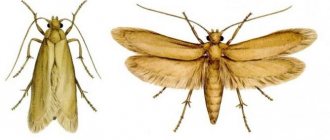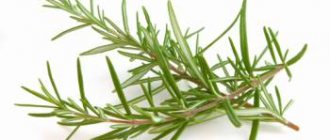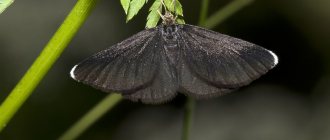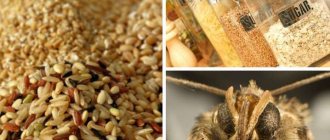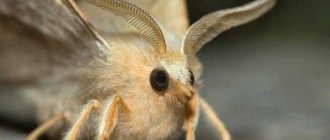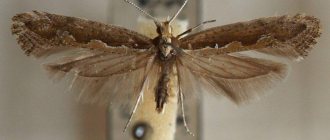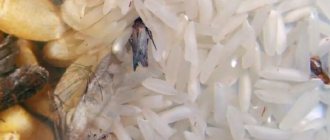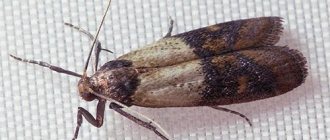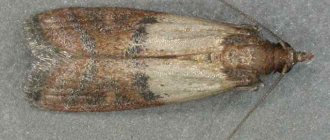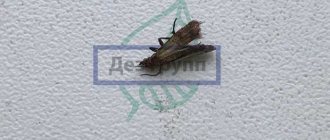The appearance of the potato butterfly is unattractive:
- Its wings are gray in color with a large number of black spots; when the insect folds its wings, these points are transformed into long dark lines.
- The harmful butterfly has antennae and a reduced mouthparts.
- The insect lives only a few days, less often weeks.
- Its length can reach 6-7 mm; due to its color, it is almost invisible to the eye.
- Insect larvae are very small in size - 13 mm.
- The harmful insect is white-pink or white-light green.
The harmful butterfly reproduces by laying eggs; they are very difficult to find even at close range. Eggs can be found on the underside of a potato leaf. When laid, the eggs are white and then darken over time. One female potato moth butterfly is capable of continuing its genus by a hundred individuals.
The life cycle of a harmful insect from egg to butterfly is about a month. This insect does not tolerate severe frosts; it dies already at -4 degrees, which is why it is not found in the North. These insects overwinter in potato tubers and can survive even if they are slightly frostbitten.
It also happens that a harmful butterfly can overwinter in open ground under a layer of fallen leaves. Potato moth can live not only on potatoes, but also on tomatoes, eggplants and peppers.
Insect larvae feed on the leaves themselves, as well as their stems and tubers.
Features of development
Potato moth - photo:
In summer, under consistently warm weather conditions, the development of a moth from egg to adult lasts 3-4 weeks. But the duration of development is influenced by the temperature factor , namely:
- + 35°C – development lasts 16 days;
- +20…+27°C – 28-30 days;
- +15…+20°C – 60-70 days;
- fluctuations from +8 to +20°C – 120-150 days;
- +10°C – development is delayed for up to 200 days.
As you can see, the potato moth is able to develop, practically regardless of the conditions surrounding it .
Story
Just some 150 years ago, potato moth was unheard of in our country. This scourge came to our country not so long ago, and the population of the southern regions was the first to become acquainted with it. The natural environment for the potato moth is Africa. It was here that hordes of pests walked in ancient times. Today, the moth has spread throughout the entire planet, where the average annual temperature does not drop below 10 degrees - only in such a climate can the moth reproduce.
It is very important to find out in time what potato moth is and how to fight it.
Pest eggs and larvae
Appearance : Potato moth eggs are round-oval in shape, reaching 0.8 mm in length and 0.4 mm in width. The color of the egg is pearly white, darkening as the embryo develops inside it.
Where are they deposited, how to detect them ? The butterfly lays eggs on the underside of a plant leaf, often near the veins, leaf petioles or on the stems. Sometimes clutches can be found on uncovered tubers and in the ground. Usually the clutch consists of 1-20 barely noticeable eggs.
caterpillars have clear segmentation and 3 pairs of dark thoracic legs. After birth, the larva is naked, pale in color, with a dark head and scutellum. The length of the newborn larva is 2 mm.
After some time, the caterpillar is covered with small dark bristles and has a pale gray or green tint . On the body you can see a pale longitudinal stripe, a dark brown head and a black shield. The body length of an adult larva is 8-12 mm.
Interesting : the color of the larva directly depends on what it feeds. Pale gray color is characteristic of caterpillars that feed on tubers, and green is the color of the larvae that feed on the vegetative part of the plant.
Quarantine measures
Quarantine measures include:
- Compliance with established rules for transporting tubers outside the phytosanitary zone.
- Examination of potatoes by a laboratory that issues certificates of the absence of pests in the samples.
In addition, there are a number of phytosanitary measures that are aimed at suppressing the source of pest infestation. These include:
- Use only healthy seed.
- Maintain a distance of at least 1 km between the place where root crops are stored and new sown areas.
- Destruction of tops before they are completely dry.
- Separate storage of tubers from different fields.
- Treatment of fields where moths were detected with insecticides.
Life cycle
The life cycle of the potato moth consists of four stages: egg, larva (caterpillar), cocoon, butterfly . The embryonic development of potato moth lasts from 5-7 days (summer) to 18-35 days (winter).
After the larva emerges from the egg, it goes through 4 instars (molting) before it turns into a pupa.
The duration of this stage depends on the temperature and living conditions .
Typically, the larva becomes an adult within 10-20 days (summer) and 45-65 days (winter).
The potato moth stays in the pupal stage from 5-6 days (in summer) to 30-90 days (in winter). After the butterfly emerges from the cocoon, it will live only a few days .
Under favorable conditions, life expectancy can be 2 weeks . But during this time it will have time to mate and lay 150-200 eggs .
Optimal temperature conditions for insect development:
- +8…+25°С – for laying eggs;
- +9…+28°С – for embryo development;
- +6…+25°С – for larval growth;
- -4...+40°С is the survival threshold of an adult.
Lifestyle
The life of the pest is associated with plants belonging to the Solanaceae family. Adult moths have a good sense of smell. She can even smell those tubers that were packed in canvas bags.
Adults cannot eat fully and live off the nutrients accumulated in the larval form.
At the same time, the insect is able to travel up to 3 km in search of plantings necessary for feeding the young.
What do potato moths eat?
Fluorimea feeds not only on potato tubers and tops. The diet of this pest includes the following crops:
- tomatoes;
- petunias;
- pepper;
- physalis;
- tobacco;
- eggplant.
In addition, some weeds may suffer from this insect, incl. Datura, black henbane and wolfberry.
Wintering of the pest
In warm regions, formed potato moth pupae overwinter under the remains of tops. In the northern regions, immediately after the tops dry out, the caterpillars move into the ground and infect the tubers. Subsequently, they pupate and remain in the soil at a depth of up to 20 cm. The emergence of adult individuals in this case occurs in May.
If the caterpillars are not yet fully formed, they remain in the tubers. They are dug up along with potatoes and stored in cellars. In larvae kept in a cool room, development proceeds more slowly. They reach adulthood only in spring.
What harm does it cause?
The main damage caused by moths to potatoes:
- weakening of potato bushes due to “mining” or complete destruction of leaves;
- damage to tubers , correspondingly, a significant decrease in the quality and quantity of the crop;
- reduction in the quality and quantity of sowing potatoes.
Signs of damage:
- entwining stems and leaves with cobwebs ;
- “mining” of tops;
- stem dying;
- wormholes under the skin and in the pulp of the tuber;
- characteristic passages in tubers filled with excrement;
- the formation of rot in damaged tissues.
Signs of the presence of potato moth
The main damage to plants is caused by caterpillars of harmful insects. How to detect potato moth?
There are certain signs by which you can understand that the plant is being harmed by potato moth:
- The larvae infect the leaves.
- Butterfly caterpillars leave certain passages on plants.
- On the leaves, if you examine it carefully, you can find small dimples with insect excrement.
- If you peel potato tubers, they will probably contain insect passages and larvae.
- When the tubers are severely damaged, the plants resemble a sponge.
- Many people confuse the passages of a wireworm with those of a moth caterpillar. In the first insect they are clean and straight, while in the second they are curled into a cobweb.
- If the caterpillar infects the top of the potato, it begins to wither and dry out.
- A cobweb appears on the leaves of the plant.
- Dry or wet rot appears.
Control measures and prevention
How to get rid of potato moth?
If infected potatoes are left on the plantation or simply thrown away, the larva will go into the ground for the winter and will appear again next season.
The fight against potato moth living in fields and plantations is carried out using the following methods :
- Plant only with seed untouched by insects to a depth of at least 15 cm.
- Carry out regular hilling of the bushes so that the young tuber crops are under at least 5 cm of soil.
- Carry out systematic destruction of weeds .
- Water the plantation using sprinkling (this will lead to the death of most adult butterflies).
- Digging up potatoes should be done at the very beginning of the tops drying out, or a week before harvesting, cut off the tops and burn them .
- Harvest the crop as quickly as possible, and remove the harvested potatoes (absolutely all!) from the field .
- Destroy tubers and trimmings damaged by the larva .
It is also recommended to initially grow early-ripening potato varieties , which are absolutely indifferent to this insect.
In addition to agricultural control methods, you can use remedies for potato moth , such as Danadim, Bi 58, Ditox, Di 68, Rogos-S.
Information about drugs that help fight this pest and how to use them can be found in the article “The best drugs for potato moth (part 1)” and “The best drugs for potato moth (part 2).”
How to deal with potato moth in the cellar
- Before lowering the harvest into the cellar, you need to carefully inspect and sort it out.
- If traces of the pest are noticed, the potatoes should be treated with biological solutions.
- The solution is made from 2 drugs: planriz and lepidocide.
- You need to take 100 liters of water and add 0.5 liters of planriz and 2 liters of lepidocide to it.
- The potatoes are immersed in the resulting solution for 10 minutes.
- After the procedure, the tubers should dry.
- It will be possible to cook food from processed potatoes in 2 days.
- There is another solution - bitoxybacillin, lepidocide or denrobacillin.
- For 150 liters of water you need to take 1 liter of a solution of any of the listed biological preparations.
- It must be processed in the same way as in the first case.
- Potatoes can also be treated with a methyl bromide solution.
- Tubers should be stored in the cellar at low temperatures.
- Before lowering the potatoes into the cellar, they need to be inspected for the presence of pests.
- If there are moths in the cellar, then it should be treated with quicklime.
- You can also use a smoke bomb against the pest “FAS” or “Gamma”.
Control measures when storing potatoes
What are control measures during storage? The main reservoir of fluorimea is the storage area of potatoes, where the pest ends up with the harvested crop . There the moth continues its development.
A huge part of tubers damaged by moths rot. Crop losses can reach 80%. This is why the fight against fluorimea when storing potatoes is so important. How to deal with potato moth in the basement?
In order to preserve the tubers, it is necessary to create unfavorable conditions for the larvae, namely to reduce the room temperature to +2-3°C.
Agrotechnical means
Biological agents are less effective than chemical drugs. They are often used as a preventive measure to prevent damage to tops and tubers by insects.
Entobacterin
Entobacterin suppresses the activity of more than 49 species of pests. The preparation contains a number of beneficial microorganisms. In 1 mg of the product there are up to 30 billion spores. The drug is diluted with warm water in a ratio of 1:10. After this, the potato bushes are sprayed with the solution.
Bitoxibacillin
Bitoxibacillin is diluted in water at the rate of 100 ml per 10 liters. They spray potato tops in the evening. It is important that the air temperature is more than +20 °C. The drug begins to act immediately after the larva enters the digestive tract. She stops feeding and dies within 5 days.
Bitoxibacillin is one of the safest insecticides for controlling potato moth.
Dendrobacillin
Dendrobacillin is available in the form of a brown powder. To obtain a solution, you need to dilute 100 g of the substance in 10 liters of warm water. Potatoes should be processed 2 times with an interval of 7 days. After eating the treated tops, the larvae experience intestinal paralysis. They stop feeding and die.
Lepidocide
This drug contains microorganisms that can destroy fluorimea at all stages of its development. Protein toxins break down the intestinal walls of caterpillars. Pests die a few days after treatment, because can't eat.
Gas tablets
Gas tablets can be used in dry and warm weather. They are placed between the rows and lit. This ensures uniform fumigation of all bushes. Often these drugs are used to fumigate basements.
Do not inhale the gas released during combustion.
Preventative work
To protect potatoes from moths, it is necessary to carry out a number of preventive measures. Even at the planting stage, preference should be given to early varieties that will have time to form before the fluorimea awakens. All planting material must be carefully examined and tubers with the slightest traces of damage must be removed. In addition, before lowering the tubers into the ground, it is recommended to keep them for 2 hours at a temperature of 40 degrees.
The potatoes must be deepened by approximately 20 centimeters, after which the bushes must be regularly hilled, and one must also remember to attach pheromone traps at a distance of 100 meters from each other. The crop should be watered using the rain method, without exposing the tubers, which will destroy a large number of adult individuals, that is, the butterflies themselves.
It is better to harvest before the tops dry out, and first, in one day, mow and burn the potato tops, and after 5-7 days, dig up all the tubers and immediately remove them from the field to prevent fluoromea butterflies from laying eggs.
Using crop rotation (planting other crops after potatoes) helps stop the proliferation of pests. It is important to remember that this plant should not live in the same area for several years in a row, nor should it end up in beds previously occupied by other nightshades. To preserve the harvest for the winter, drying the fruits, as well as their further treatment with Entobacterin, will be useful. By the way, it is better to immediately burn the affected tubers. Potatoes should be stored at a temperature of approximately 3-5°C. Of course, at lower temperatures from -2 to -4, the insect will die faster, but the tubers themselves will also turn black, which is not desirable.
What is this insect?
To know who you have to fight with, you need to read the description of the pest, it will help to destroy it in a timely manner. Having detected the presence of an insect by certain signs.
The potato moth is a small butterfly. It is very inconspicuous and dangerous, and can destroy up to 80% of the crop.
Pest characteristics:
- Scientific name: Fluorimea.
- Size – 6–8 mm in length, 12–13 mm wingspan.
- The color is inconspicuous gray, with small black dots on the wings. When the insect folds them, the dots form dark stripes.
- The antennae are long.
- The mouthparts are small.
